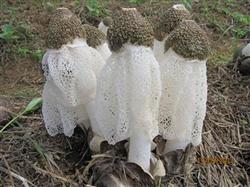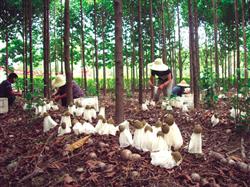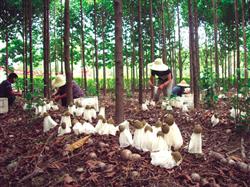Dictyophora planting: what are the diseases and insect pests of Dictyophora?

What are the diseases and insect pests of planting Dictyophora? Please introduce and guide the prevention and control of Dictyophora is a valuable edible fungus treasure, the use of drugs to control diseases and insect pests is prohibited during the fruiting body growth. Therefore, the prevention and control of diseases and insect pests should start with environmental factors and give priority to prevention, and comprehensive measures should be taken as follows: (1) to remove miscellaneous bacteria and pollutants on the border during mycelium management, and to find "black, red and green" color mixed bacteria, immediately cover the external film with ammonium bicarbonate or lime, disinfect and inhibit. If miscellaneous bacteria appear during the mushroom emergence period, chlortetracycline aqueous solution can be sprayed before the skirt of Dictyophora, and 0.1% carbendazim solution can be sprayed for prevention and control in severe cases. (2) in order to prevent the loss of yield caused by the infection of miscellaneous bacteria in a large area, the cultivation field of Dictyophora should not be continuous cropping, and rice should be replanted after three years. (3) pest control 1. Tea bran pest control. Adding 35% tea bran (tea seed cake) powder to the culture material or mixing the culture material with boiled tea bran water can effectively control insect pests. 2. Manual capture. Artificial capture of pests in the presence of pests. 3. Chemical control (1) termites: can eat the hyphae of Dictyophora, affecting the yield of Dictyophora. It can be sprayed with mirex or phoxim 700x, 25% chrysanthemum 2000 times, or sprinkled with alum powder on the awn dustpan that termites like to eat, or incense-burning bones. (2) mites: it is easy to break out in high temperature and humidity, and it occurs in both the mycelium growth stage and the mushroom stage, which can bite off the hyphae, shrink the hyphae, bite the Dictyophora ball and spread germs, resulting in a bad harvest when it occurs seriously. It can be sprayed with 70% propargite 200 times or 2.5% Uranus 2000 times or other special acaricides. (3) slug: a mollusk, commonly known as "slug", without shell, naked body, mainly engulfing Dictyophora ball, causing ball perforation and leaving a white mucus. Fenitrothion can be sprayed or trapped with 1:50:50 calcium arsenate, wheat husk and water in slug-infested places, or 5% cresol soap solution and 50% salt water can be sprayed in slug-infested places. (4) Prevention and control of diseases 1. Slime mold: it occurs on the bare soil or covered rice straw on the surface of Dictyophora border. At the initial stage, it is sticky and will deform and move, showing milky white, orange-yellow and yellowish green, so that the growth of mycelium is restrained or gradually wiped out, and in serious cases, it no longer grows Dictyophora. Ventilation should be strengthened. In the initial stage, carbendazim, 1000-fold solution of thiophanate methyl, 500x solution of copper sulfate and 10% bleaching powder can be sprayed continuously for 3 times for 4 times. 2. Botrytis cinerea: it often occurs in the environment of high temperature and humidity. In the initial stage, the dirty white fluffy hyphae appeared in the overlying soil layer of Dictyophora border, which soon turned pink and black, and the colony was dark smoky gray, and produced a large number of black spores, which mainly harmed the hyphae of Dictyophora, resulting in mycelium breakage and death. Early appearance of dirty white villous hyphae is the best period for treatment, 3% carbonic acid or 2% formaldehyde can be sprayed directly on the disease; when black spores appear, 700 times dilution of formalin 20 times + 70% methyl topiramate wettable powder can be sprayed; in severe cases, cut off the culture material around the affected area, sprinkle fresh lime in and around the affected area, and cover the affected area with plastic film to control its spread. Click to get more planting techniques of Dictyophora, click to get more planting techniques of edible fungi
- Prev

Dictyophora planting: how can Dictyophora produce high yield?
How can Dictyophora be planted with high yield? Please introduce the method of Dictyophora planting in order to obtain high yield, we should pay attention to the following points: 1. Cultivation site: choose sandy loam woodland with convenient drainage and irrigation, and make a border under a forest with a canopy degree of 80%, with a depth of 15-20 cm, a width of 40 ─ 50 cm, and a north-south direction.
- Next

Dictyophora planting: how can Dictyophora grow high yield?
How can Dictyophora be planted with high yield? Please give guidance to Dictyophora cultivation in order to obtain high yield, it is necessary to know how to grow Dictyophora. The following is to introduce a planting technique for Dictyophora: first, the field requires convenient transportation, loose and fertile soil, high humus content, strong air permeability and not easy board.
Related
- Fuxing push coffee new agricultural production and marketing class: lack of small-scale processing plants
- Jujube rice field leisure farm deep ploughing Yilan for five years to create a space for organic food and play
- Nongyu Farm-A trial of organic papaya for brave women with advanced technology
- Four points for attention in the prevention and control of diseases and insect pests of edible fungi
- How to add nutrient solution to Edible Fungi
- Is there any good way to control edible fungus mites?
- Open Inoculation Technology of Edible Fungi
- Is there any clever way to use fertilizer for edible fungus in winter?
- What agents are used to kill the pathogens of edible fungi in the mushroom shed?
- Rapid drying of Edible Fungi

